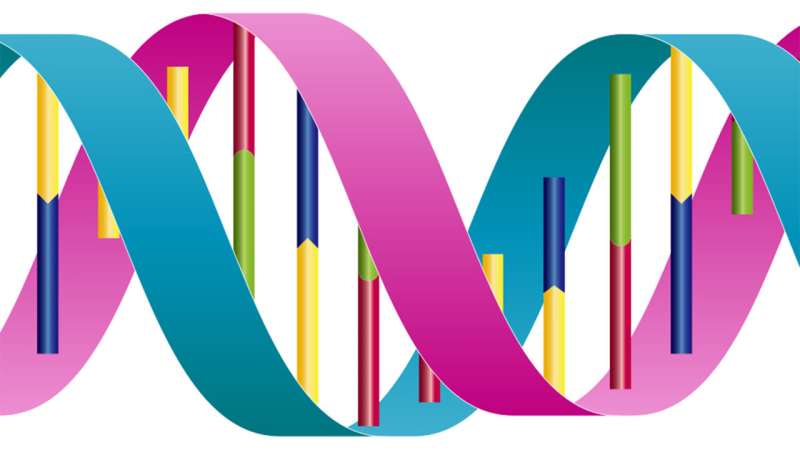'Proofreading' proteins stop and reel in DNA to correct replication errors

On the DNA assembly line, two proofreading proteins work together as an emergency stop button to prevent replication errors. New research from North Carolina State University and the University of North Carolina at Chapel Hill shows how these proteins—MutL and MutS—prevent DNA replication errors by creating an immobile structure that calls more proteins to the site to repair the error. This structure could also prevent the mismatched region from being "packed" back into the cell during division.
When a cell prepares to divide, the DNA splits, with the double helix "unzipping" into two separate backbones. New nucleotides—adenine, cytosine, guanine or thymine—are filled into the gaps on the other side of the backbone, pairing with their counterparts (adenine with thymine and cytosine with guanine) and replicating the DNA to make a copy for both the old and the new cells. The nucleotides are a correct match most of the time, but occasionally—about one time in 10 million—there is a mismatch.
"Although mismatches are rare, the human genome contains approximately six billion nucleotides in every cell, resulting in approximately 600 errors per cell, and the human body consists of more than 37 trillion cells," says Dorothy Erie, chemistry professor at UNC-Chapel Hill, member of UNC's Lineberger Comprehensive Cancer Center and co-corresponding author of the work. "Consequently, if these errors go unchecked they can result in a vast array of mutations, which in turn can result in a variety of cancers, collectively known as Lynch Syndrome."
A pair of proteins known as MutS and MutL work together to initiate repair of these mismatches. MutS slides along the newly created side of the DNA strand after it's replicated, proofreading it. When it finds a mismatch, it locks into place at the site of the error and recruits MutL to come and join it. MutL marks the newly formed DNA strand as defective and signals a different protein to gobble up the portion of the DNA containing the error. Then the nucleotide matching starts over, filling the gap again. The entire process reduces replication errors around a thousand-fold, serving as one of our body's best defenses against genetic mutations that can lead to cancer.
"We know that MutS and MutL find, bind, and recruit repair proteins to DNA," says biophysicist Keith Weninger, university faculty scholar at NC State and co-corresponding author of the work. "But one question remained—do MutS and MutL move from the mismatch during the repair recruiting process, or stay where they are?"
In two separate papers appearing in Proceedings of the National Academy of Sciences, Weninger and Erie looked at both human and bacterial DNA to gain a clearer temporal and structural picture of what happens when MutS and MutL engage in mismatch repair.
Using both fluorescent and non-fluorescent imaging techniques, including atomic force microscopy, optical spectroscopy and tethered particle motion, the researchers found that MutL "freezes" MutS in place at the site of the mismatch, forming a stable complex that stays in that vicinity until repair can take place. The complex appears to reel in the DNA around the mismatch as well, marking and protecting the DNA region until repair can occur.
"Due to the mobility of these proteins, current thinking envisioned MutS and MutL sliding freely along the mismatched strand, rather than stopping," Weninger says. "This work demonstrates that the process is different than previously thought.
"Additionally, the complex's interaction with the strand effectively stops any other processes until repair takes place. So the defective DNA strand cannot be repacked into a chromosome and then carried forward through cell division."
More information: Pengyu Hao et al, Recurrent mismatch binding by MutS mobile clamps on DNA localizes repair complexes nearby, Proceedings of the National Academy of Sciences (2020). DOI: 10.1073/pnas.1918517117
Journal information: Proceedings of the National Academy of Sciences
Provided by North Carolina State University





















